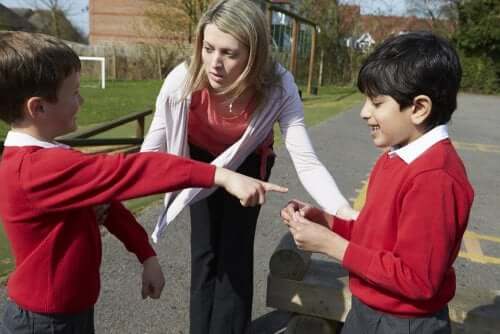The Role of Families in Putting a Stop to Bullying


Written and verified by the psychologist María Alejandra Castro Arbeláez
It’s very important to point out the role that families play in putting a stop to bullying. For that reason, we want to show you some guidelines regarding how you can do your part to combat this disturbing social epidemic.
Families are the main nucleus where children grow up and experience their first social experiences. These experiences leave their mark on the way children behave in other contexts, including when they’re at school. From the earliest years of life, you can teach your children to have the confidence and empathy they need for the proper development of their personalities.
As a mother or father, you need to take on the responsibility of following good educational practices… practices based on respect, care, and affection. That way, your children will learn to tolerate frustration, accept diversity, resolve conflicts, and handle anger and stress.
How should we educate our children at home?
Education in the home should meet certain basic requirements so that families can help put a stop to bullying. These fundamental conditions are beneficial when it comes to avoiding the appearance of other types of negative behaviors and attitudes as well.
According to psychologist María José Díaz Aguado, parents need to provide their children with the following:
- Continuous attention: This refers to the act of responding sensitively to the demands and needs of our children.
- Unconditional emotional support: This consists of providing care and affection when our children need it.
- Consistent discipline: Here, Díaz Aguado refers to the establishment of clear limits and the correction of poor behavior.
- Opportunities to learn to control their emotions and behaviors. This means teaching them to resolve conflicts in a positive and constructive fashion.

In this sense, it’s crucial to emphasize the importance of teaching children the ability to empathize. In other words, we need to help our children put themselves in someone else’s shoes and understand different perspectives. It’s also important to help them see that their actions have consequences and, therefore, they should think before they act.
At the same time, we need to teach them to remain calm even during stressful situations so they know how to respond properly.
It’s also important for parents to control the messages their children receive from TV, the internet, and video games. These messages should coincide with the values you’re trying to instill.
This way, children extrapolate what they learn within their family circle to their academic setting. Their behavior will be respectful and they’ll get along with others, which will help put a stop to bullying.
The relationship between attachment and bullying at school
The construction of a safe attachment between children and their families helps protect children from bullying. In other words, when mothers and fathers give their children confidence, security, and communication, they indirectly teach them to reject bullying.
On the contrary, there are also children who develop an insecure attachment with one of their main caregivers. These kids learn not to expect protection from others, leading them to develop a negative outlook on life. This, in turn, increases their vulnerability and the likeliness of displaying violent conduct.
Risk factors within the family that contribute to the incidence of bullying
There are various risk factors that can exist within a family that increase the chances of bullying. Some of these characteristics are the following:
- A lack of cohesion among family members.
- The absence of a warm, safe and caring relationship.
- The use of violence in raising a child.
- Difficulties when it comes to teaching children to respect limits and norms.
- Permissiveness regarding antisocial behaviors.
- The application of authoritarian methods.
As a mother or father, you need to avoid all of the above. Children imitate what they see at home, especially when they’re small, and they repeat it at school. Remember that you’re the most important role model for your kids.
Therefore, be careful about the way you behave around them and make sure you’re modeling the values you want them to learn. The way you treat them will greatly influence the way they will treat others.

Finally, I’d like to close with the following quote from Nelson Mandela:
“Education is the most powerful weapon which you can use to change the world.”
– Nelson Mandela –
So, let’s change the world, right from our very own homes! Let’s try to create a world that treats everyone with equality… where discrimination no longer exists.
Let’s start by giving our little ones an education that’s based on respect for diversity, cooperation, and getting along. Together, we can put a stop to bullying!
It’s very important to point out the role that families play in putting a stop to bullying. For that reason, we want to show you some guidelines regarding how you can do your part to combat this disturbing social epidemic.
Families are the main nucleus where children grow up and experience their first social experiences. These experiences leave their mark on the way children behave in other contexts, including when they’re at school. From the earliest years of life, you can teach your children to have the confidence and empathy they need for the proper development of their personalities.
As a mother or father, you need to take on the responsibility of following good educational practices… practices based on respect, care, and affection. That way, your children will learn to tolerate frustration, accept diversity, resolve conflicts, and handle anger and stress.
How should we educate our children at home?
Education in the home should meet certain basic requirements so that families can help put a stop to bullying. These fundamental conditions are beneficial when it comes to avoiding the appearance of other types of negative behaviors and attitudes as well.
According to psychologist María José Díaz Aguado, parents need to provide their children with the following:
- Continuous attention: This refers to the act of responding sensitively to the demands and needs of our children.
- Unconditional emotional support: This consists of providing care and affection when our children need it.
- Consistent discipline: Here, Díaz Aguado refers to the establishment of clear limits and the correction of poor behavior.
- Opportunities to learn to control their emotions and behaviors. This means teaching them to resolve conflicts in a positive and constructive fashion.

In this sense, it’s crucial to emphasize the importance of teaching children the ability to empathize. In other words, we need to help our children put themselves in someone else’s shoes and understand different perspectives. It’s also important to help them see that their actions have consequences and, therefore, they should think before they act.
At the same time, we need to teach them to remain calm even during stressful situations so they know how to respond properly.
It’s also important for parents to control the messages their children receive from TV, the internet, and video games. These messages should coincide with the values you’re trying to instill.
This way, children extrapolate what they learn within their family circle to their academic setting. Their behavior will be respectful and they’ll get along with others, which will help put a stop to bullying.
The relationship between attachment and bullying at school
The construction of a safe attachment between children and their families helps protect children from bullying. In other words, when mothers and fathers give their children confidence, security, and communication, they indirectly teach them to reject bullying.
On the contrary, there are also children who develop an insecure attachment with one of their main caregivers. These kids learn not to expect protection from others, leading them to develop a negative outlook on life. This, in turn, increases their vulnerability and the likeliness of displaying violent conduct.
Risk factors within the family that contribute to the incidence of bullying
There are various risk factors that can exist within a family that increase the chances of bullying. Some of these characteristics are the following:
- A lack of cohesion among family members.
- The absence of a warm, safe and caring relationship.
- The use of violence in raising a child.
- Difficulties when it comes to teaching children to respect limits and norms.
- Permissiveness regarding antisocial behaviors.
- The application of authoritarian methods.
As a mother or father, you need to avoid all of the above. Children imitate what they see at home, especially when they’re small, and they repeat it at school. Remember that you’re the most important role model for your kids.
Therefore, be careful about the way you behave around them and make sure you’re modeling the values you want them to learn. The way you treat them will greatly influence the way they will treat others.

Finally, I’d like to close with the following quote from Nelson Mandela:
“Education is the most powerful weapon which you can use to change the world.”
– Nelson Mandela –
So, let’s change the world, right from our very own homes! Let’s try to create a world that treats everyone with equality… where discrimination no longer exists.
Let’s start by giving our little ones an education that’s based on respect for diversity, cooperation, and getting along. Together, we can put a stop to bullying!
All cited sources were thoroughly reviewed by our team to ensure their quality, reliability, currency, and validity. The bibliography of this article was considered reliable and of academic or scientific accuracy.
- Díaz-Aguado, M. J. (2006). El acoso escolar y la prevención de la violencia desde la familia. Madrid: Dirección General de la Familia.
- Trautmann, A. (2008). Maltrato entre pares o” bullying”: Una visión actual. Revista chilena de pediatría, 79(1), 13-20. doi: 10.4067/S0370-41062008000100002
This text is provided for informational purposes only and does not replace consultation with a professional. If in doubt, consult your specialist.








